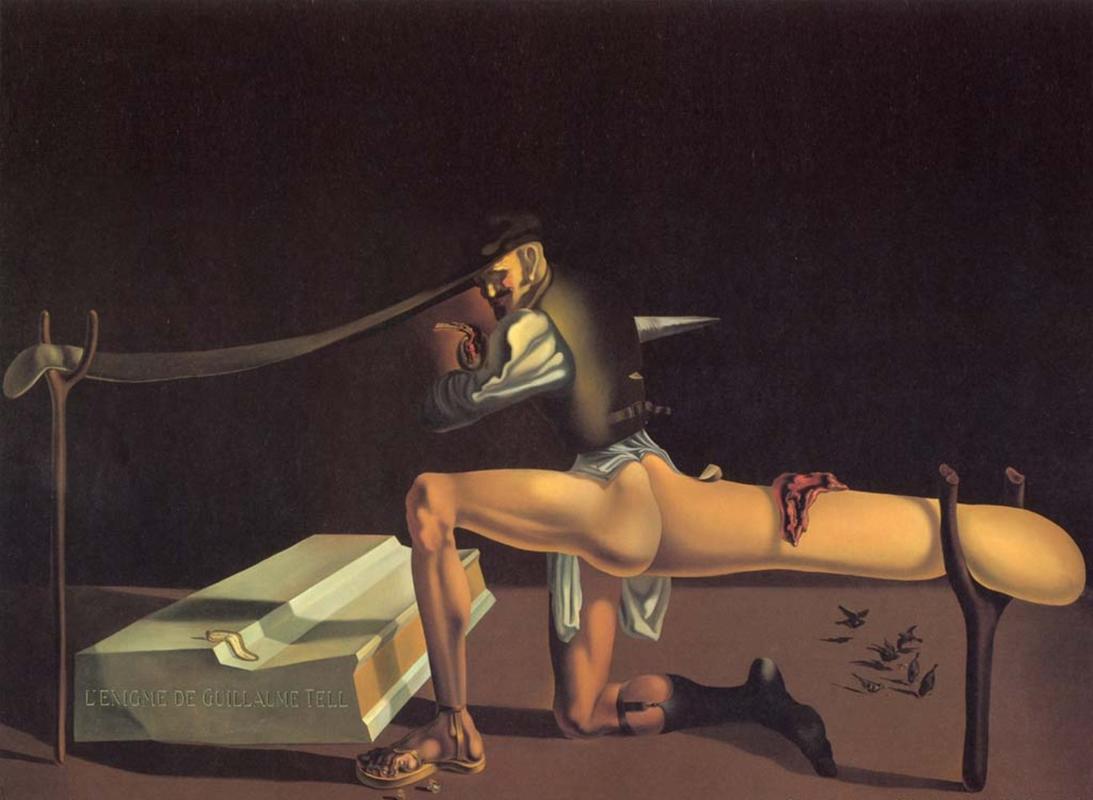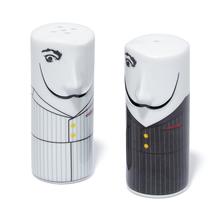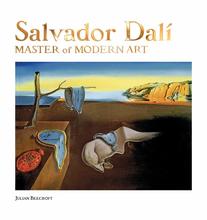More about The Enigma of William Tell
- All
- Info
- Shop

Contributor
If you think you’re looking at famous Swiss hero William Tell in this painting, you’d only be partially right.
Take a closer look at the face and cap and you’ll see Communist leader Vladimir Lenin standing in for ol’ Bill. For Dalí, both Tell and Lenin represented political father-figures he wished to rebel against. Not surprisingly, this work was also a way for him to rebel against his own father. Way to be, Dalí: spitting on three authoritative figures for the price of one.
No matter which depiction we choose, this William Tell character isn’t painted in the most pleasing light. If you haven’t noticed, the dude’s right buttock is like eight feet long, a size Dalí once compared to “a breakfast roll with its end held up by a forked crutch.” Whether Dalí was just calling Lenin/Tell/Dad a butthead or impotent is up for debate, but we can safely disregard any attempts at flattery.
For those of us who don’t know the famous tale, William Tell was the legendary hero who was forced to shoot an apple off of his son’s head with an arrow—all for refusing to take his hat off when passing by the Duke of Austria’s own hat hanging from a pole (scandalous!). Suffice to say, Tell’s refusal, successful shot, and subsequent murder of the grumpy bailiff who put him up to it sparked a revolution that led to Switzerland’s prosperous independence. Nowadays, Tell is so adored by the Swiss people that you can’t so much as sneeze in front of his statue, let alone respectfully suggest that the guy never existed, without them chasing you out of the country with torches and pitchforks.
Jean-Francois Bergier, a former Swiss professor of history and William Tell biographer, calls Tell a father-figure for the Swiss people, “Unspoken but always present.” To give a sobering example: after refusing to acknowledge the supposed atrocity that is Daylight Savings Time, a Swiss farmer once stated: “We live on William Tell time.” So, yeah. They’re pretty possessive of the guy over there.
At the time Dalí painted The Enigma of Wilhelm Tell, he may very well have seen Lenin as a comparable father-figure to Tell, admired as he was by surrealists of the time, many of whom had communist sympathies. When the artists first saw Dalí's painting, they immediately tried to tear it to pieces. Andre Breton told Dalí he disliked his rendition of the human buttocks (to which Dalí, of course, responded by putting far more of them in his later works).
Eventually, Breton called a mock-trial for the surrealists to banish Dalí from the group forever. Dalí attended the meeting with a fever and sore throat, taking on and off his coats and scarves and distracting everybody from Breton’s testimony. Finally, he spoke to Breton’s concerns, spitting through the thermometer in his mouth and stating: “Lenin’s anamorphic buttock was not insulting, but the very proof for my fidelity to surrealism.”
Boom. Checkmate. By the end of the meeting, Dalí was not excluded from the group, but the surrealists had become increasingly divided over this strange and provocative artist.
Sources
- Chimera, Paul. “Dali’s Parental Disenchantment Clear in ‘Enigma of William Tell.’” www.dali.com. Accessed March 11, 2018. http://www.dali.com/dalis-parental-disenchantment-clear-in-enigma-of-wi…
- Dali Paintings Editors. “The Enigma of William Tell, 1933 by Salvador Dali.” www.dalipaintings.com. Accessed March 11, 2018. https://www.dalipaintings.com/the-enigma-of-william-tell.jsp
- Greene, Robert. The 33 Strategies of War. London: Profile Books, 2010.
- Moderna Museet Editors. “The Enigma of Wilhelm Tell, 1933.” www.modernamuseet.se/stockholm/sv. Accessed March 11, 2018. http://sis.modernamuseet.se/view/objects/asitem/acq$00402180:en/5/prima…
- The Telegraph Editors. “10 pieces of modern art that shocked the world.” www.telegraph.co.uk. Accessed March 11, 2018. https://www.telegraph.co.uk/art/artists/shocking-controversial-pieces-m…
- Wernick, Robert. “In Search of William Tell.” www.smithsonianmag.com. Accessed March 11, 2018. https://www.smithsonianmag.com/history/in-search-of-william-tell-219851…













